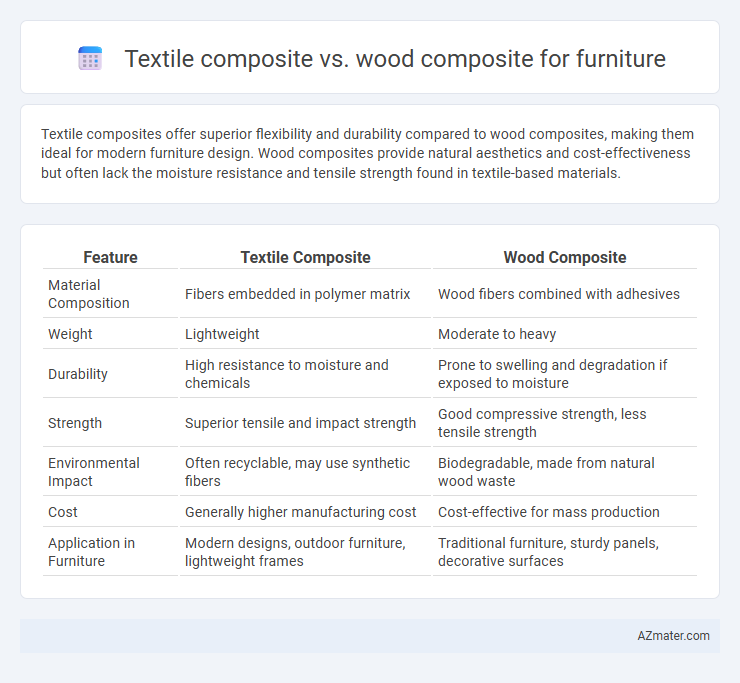Textile composites offer superior flexibility and durability compared to wood composites, making them ideal for modern furniture design. Wood composites provide natural aesthetics and cost-effectiveness but often lack the moisture resistance and tensile strength found in textile-based materials.
Table of Comparison
| Feature | Textile Composite | Wood Composite |
|---|---|---|
| Material Composition | Fibers embedded in polymer matrix | Wood fibers combined with adhesives |
| Weight | Lightweight | Moderate to heavy |
| Durability | High resistance to moisture and chemicals | Prone to swelling and degradation if exposed to moisture |
| Strength | Superior tensile and impact strength | Good compressive strength, less tensile strength |
| Environmental Impact | Often recyclable, may use synthetic fibers | Biodegradable, made from natural wood waste |
| Cost | Generally higher manufacturing cost | Cost-effective for mass production |
| Application in Furniture | Modern designs, outdoor furniture, lightweight frames | Traditional furniture, sturdy panels, decorative surfaces |
Introduction to Textile and Wood Composites in Furniture
Textile composites in furniture combine natural or synthetic fibers with resins to create lightweight, durable, and flexible materials ideal for modern designs. Wood composites, such as particleboard and MDF, integrate wood fibers, adhesives, and fillers to offer cost-effective, stable, and eco-friendly alternatives to solid wood. Both materials enhance furniture performance by balancing aesthetics, strength, and sustainability in contemporary manufacturing.
Composition and Manufacturing Processes
Textile composites for furniture typically consist of natural or synthetic fibers like carbon, glass, or aramid embedded in polymer matrices, offering high strength-to-weight ratios and flexibility. Wood composites combine wood fibers or particles with adhesives and resins, utilizing processes such as hot pressing or extrusion to create materials like MDF, particleboard, or plywood. Manufacturing textile composites involves layering and curing techniques under controlled heat and pressure, whereas wood composites rely on mechanical pressing and bonding to achieve structural integrity.
Mechanical Properties and Strength Comparison
Textile composites exhibit superior tensile strength and flexibility compared to wood composites, making them ideal for dynamic load-bearing furniture applications. Wood composites, while generally offering higher compressive strength and stiffness, tend to have lower impact resistance and are more susceptible to moisture-related deformation. Advanced textile composites with high-modulus fibers provide enhanced durability and fatigue resistance, outperforming traditional wood composites in long-term structural integrity.
Aesthetic and Design Flexibility
Textile composites offer superior design flexibility due to their ability to be molded into complex shapes and incorporate vibrant colors and patterns, enhancing aesthetic options in furniture design. Wood composites provide a natural, warm appearance with versatile finishes that appeal to traditional and contemporary styles but have more limitations in shaping and texture variations. The choice between textile and wood composites significantly impacts the visual appeal and creative possibilities in furniture manufacturing.
Environmental Impact and Sustainability
Textile composites in furniture offer enhanced sustainability by utilizing recycled fibers and reducing reliance on virgin materials, significantly lowering carbon emissions compared to traditional wood composites. Wood composites, often derived from waste wood or fast-growing species, promote forest resource efficiency but may involve adhesives with high environmental footprints. Evaluating lifecycle impacts reveals textile composites generally provide superior eco-friendly advantages through biodegradability and reduced deforestation pressure.
Durability and Maintenance Considerations
Textile composites in furniture offer superior resistance to moisture, stains, and UV exposure, making them highly durable and low-maintenance compared to wood composites. Wood composites, while aesthetically appealing, are prone to swelling, warping, and degradation under prolonged exposure to humidity and require regular sealing or refinishing to maintain structural integrity. Choosing textile composites reduces long-term upkeep costs and enhances lifespan, especially in environments with variable temperature and moisture levels.
Cost Efficiency and Market Availability
Textile composites offer greater cost efficiency in furniture production due to lower raw material and manufacturing expenses compared to wood composites, which require extensive processing and higher material costs. Market availability favors wood composites because of their established supply chains and widespread consumer acceptance, while textile composites are emerging with limited but growing accessibility. Choosing between these materials depends on balancing budget constraints and the desired availability for large-scale furniture manufacturing.
Applications in Modern Furniture Design
Textile composites offer enhanced flexibility and lightweight properties, making them ideal for ergonomic seating and innovative curved furniture designs in modern interiors. Wood composites provide superior structural strength and durability, frequently utilized in cabinetry, shelving, and load-bearing furniture components. Both materials enable sustainable design solutions, with textile composites excelling in upholstery applications, while wood composites support eco-friendly modular furniture systems.
User Comfort and Ergonomic Factors
Textile composites in furniture offer superior breathability and flexibility, enhancing user comfort by adapting to body contours and reducing pressure points. Wood composites provide structural support and rigidity but may lack the cushioning effect that textile composites deliver, potentially impacting prolonged ergonomic comfort. Integrating textile composites with wood frameworks can optimize both ergonomic support and comfort by combining durability with adaptive softness.
Future Trends in Composite Furniture Materials
Textile composites in furniture are gaining traction due to their lightweight properties, enhanced flexibility, and sustainability through recycled fibers, contrasting with wood composites which offer superior structural strength and traditional aesthetics. Future trends indicate increasing integration of bio-based resins and nanotechnology in textile composites to improve durability and environmental performance. Advancements in hybrid composites combining wood and textile elements are also expected to create innovative furniture designs that balance strength, comfort, and eco-friendliness.

Infographic: Textile composite vs Wood composite for Furniture
 azmater.com
azmater.com